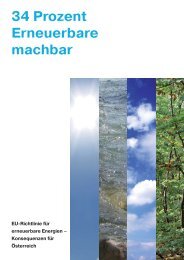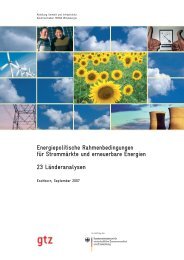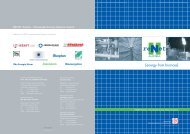K u rzfassu n g sb an d - Graz University of Technology
K u rzfassu n g sb an d - Graz University of Technology
K u rzfassu n g sb an d - Graz University of Technology
- Keine Tags gefunden...
Sie wollen auch ein ePaper? Erhöhen Sie die Reichweite Ihrer Titel.
YUMPU macht aus Druck-PDFs automatisch weboptimierte ePaper, die Google liebt.
Energieinnovation 2006 91<br />
4.3.2 „Energy saving potential <strong>of</strong> cars with <strong>an</strong> optimised powertrain<br />
compared to conventional cars“<br />
Andreas Jörg, Dierk Schröder (TU-München/Lehrstuhl für Elektrische<br />
Antriebssysteme) 1<br />
The optimised powertrain <strong>of</strong> the Technical <strong>University</strong> <strong>of</strong> Munich<br />
At the Technical <strong>University</strong> <strong>of</strong> Munich a new powertrain is under development. It consists <strong>of</strong> a<br />
conventional combustion engine (CE), a continuous variable tr<strong>an</strong>smission (CVT), <strong>an</strong> electrical motor<br />
<strong>an</strong>d a stack <strong>of</strong> double layer capacitors (UltraCap).<br />
Why using <strong>an</strong> UltraCap instead <strong>of</strong> a battery<br />
Former hybrid car solutions included large <strong>an</strong>d heavy weight batteries to drive certain dist<strong>an</strong>ces like<br />
e.g. in cities without the usage <strong>of</strong> the CE. Today smaller batteries with less capacity <strong>an</strong>d less weight or<br />
UltraCaps are used as electrical energy storage devices (EESD). These solutions only provide energy<br />
for very short dist<strong>an</strong>ces like a few stop <strong>an</strong>d go cycles. Former hybrid solutions had the target to drive<br />
longer dist<strong>an</strong>ces like e.g. within a city without emissions. Because <strong>of</strong> <strong>an</strong> improved exhaust<br />
aftertreatment, emission problems are mitigated <strong>an</strong>d recently fuel saving requirements <strong>an</strong>d<br />
accept<strong>an</strong>ce by the customer are import<strong>an</strong>t. So a small weight <strong>of</strong> EESD is aspired. The adv<strong>an</strong>tages <strong>of</strong><br />
UltraCaps are the small equivalent series resistor (ESR) <strong>an</strong>d the high power density resulting from<br />
this. This me<strong>an</strong>s there are fewer losses while storing or delivering power to or from the UltraCap thus<br />
higher efficiency <strong>of</strong> the whole powertrain c<strong>an</strong> be achieved. Besides the costs for UltraCaps are less<br />
th<strong>an</strong> for high power batteries.<br />
Operating strategy for hybrid cars<br />
For a conventional car with m<strong>an</strong>ual gear the operating strategy for detecting the fuel consumption for<br />
st<strong>an</strong>dard cycles are strictly defined, whereas with automated gears the inbuilt operating strategy is<br />
used. The operating strategy <strong>of</strong> a hybrid car has a great influence on the fuel consumption, <strong>an</strong>d there<br />
are different methods <strong>an</strong>d approaches to do this.<br />
On the one h<strong>an</strong>d there are <strong>of</strong>fline optimisation methods like linear or nonlinear programming. These<br />
methods take the whole cycle information or terrain information into consideration <strong>an</strong>d calculate the<br />
minimal possible fuel consumption. These methods c<strong>an</strong> only be used, if the whole driving cycle is<br />
known, but in real time operation the future is unknown. Nevertheless <strong>of</strong>fline methods c<strong>an</strong> be used to<br />
detect the theoretical minimum <strong>an</strong>d to get a reference for comparison with <strong>an</strong> online method.<br />
On the other h<strong>an</strong>d there are various approaches for real time operation <strong>of</strong> a hybrid car, e.g. loss<br />
minimization, fuzzy logic, neural networks or knowledge based methods are employed. The target <strong>of</strong><br />
<strong>an</strong> optimized operation <strong>of</strong> a hybrid car should be minimal fuel consumption <strong>of</strong> course. But also driving<br />
pleasure <strong>an</strong>d customer friendly requirements have to be taken into account. The main problem, that<br />
has to be solved within <strong>an</strong> online optimization, is the energy m<strong>an</strong>agement <strong>of</strong> the EESD. By using as<br />
much information as available, like GPS, terrain <strong>an</strong>d traffic information the energy m<strong>an</strong>agement <strong>an</strong>d<br />
therewith also the efficiency c<strong>an</strong> be improved, so the target to reach the over all efficiency <strong>of</strong> the <strong>of</strong>fline<br />
optimisation c<strong>an</strong> be converged.<br />
1 Institute <strong>of</strong> Elektrical Drive Systems, Technical <strong>University</strong> <strong>of</strong> Munich;<br />
Arcisstr. 21, 80333 München, Germ<strong>an</strong>y, Tel: +49 89 289 28451;<br />
e-mail: <strong>an</strong>dreas.joerg@tum.de, Url: http://www.eat.ei.tum.de;





